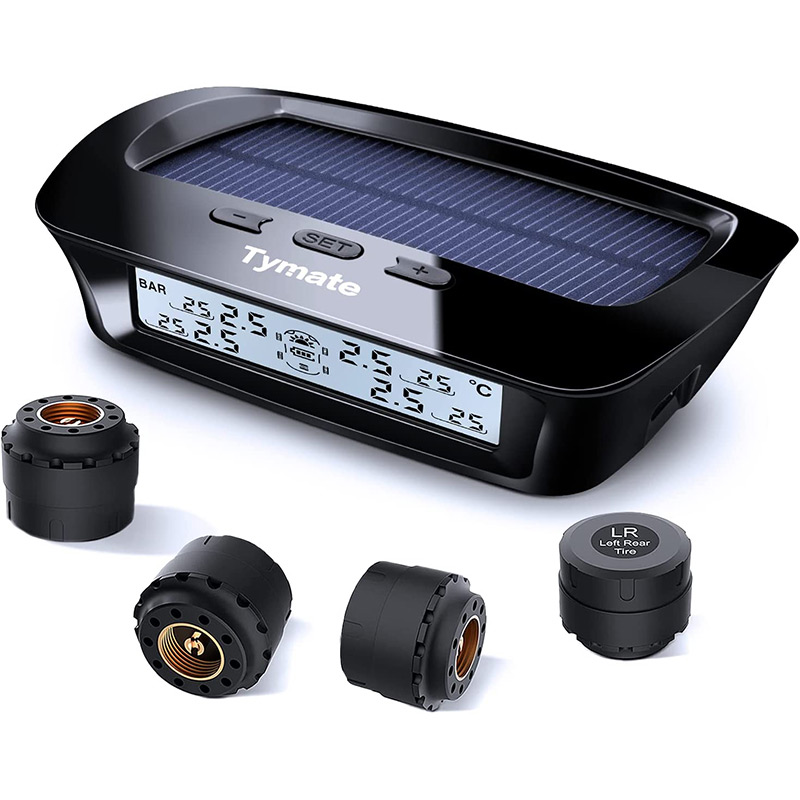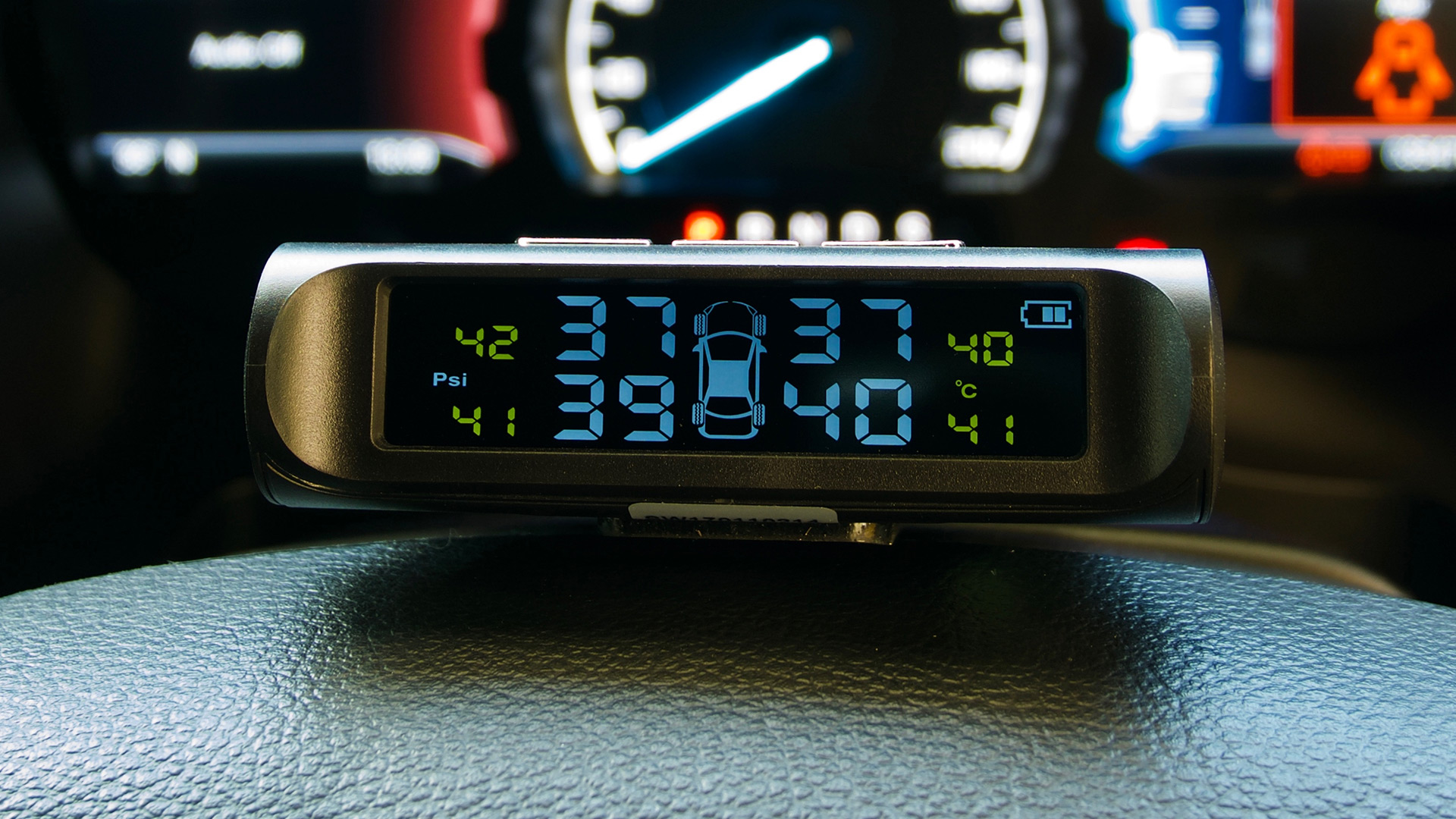Although newer vehicles are required to have a tire pressure monitoring system straight from the factory, there are still plenty of cars on today’s roads that aren’t equipped with TPMS. If you own one of those vehicles and just assumed that you couldn’t add TPMS to your car, think again. The aftermarket has several solutions to not only quickly add TPMS to an older vehicle, but to do it without having to spend hundreds of dollars.
Now, given their price tags, these systems aren’t as good as what comes factory on a vehicle. But they do a good enough job for the most part. They may not be the most accurate when it comes to your actual tire pressure, but they will alert you when a tire is overinflated or underinflated. More importantly, these systems will let you know if your tire quickly loses a lot of pressure, which often indicates a puncture or other damage.
In other words, we recommend installing an aftermarket TPMS on your vehicle to monitor drops in your tire pressure, rather than using it to know exactly how much tire pressure you have. These recommendations are still capable of doing the latter, just within a margin of error. The more important factor is knowing when a tire is underinflated or overinflated.
1. Top pick: Tymate M12-3 tire pressure monitoring system

Pros
- Easy to setup
- Good reputation and customer service
- Solar powered display so you don’t have to keep it plugged in
Cons
- Sensors seem hit or miss
- Display can be difficult to read in certain situations
Through our research, we found that Tymate offers several different TPMS, but this one has the best ratings and appears to have the best set of features. The Tymate M12-3 uses automatic solar charging for the display, but it can also be plugged into a USB port for power. It allows the user to set five different types of alerts: high pressure, low pressure, high temperature, rapid air leakage, and sensor low battery alarm. Since every vehicle’s recommended tire pressure differs, owners can set the minimum and maximum values for these alarms.
It’s also our top pick because once you properly install it and set it up, it’ll work on its own with very little maintenance. The display is backlit and will automatically enter a sleep mode if your vehicle hasn’t moved for 10 minutes. It automatically wakes up once your vehicle is turned on.
The external sensors are easy to install and each one is sealed to protect it against dust, water, and snow. This particular TPMS monitors from 0 to 87 PSI, and alarms can be set anywhere from 12 PSI to 87 PSI. Temperature monitoring covers -4°F to 176°F, while alarms can be set from 77°F to 176°F. You can also toggle between Fahrenheit and Celsius for temperature unit, and Bar or PSI for tire pressure.
Users praise this TPMS for how easy it is to setup and the majority of owners have not had any issues. There are some however, who report the sensors going dead after just a few weeks. You will likely run into QA issues with many of these products, but it does appear Tymate has a solid reputation and customer service.
2. Runner-up: VESAFE wireless tire pressure monitoring system

Pros
- Very easy to setup and install
- Takes up very little space in your car
- 18-month warranty
Cons
- Extremely basic
- Temperature is only in Celsius
- Display can be hard to read depending on the location of your cigarette lighter receptacle
For something that is even simpler, VESAFE’s TPMS might be as easy as it gets to install, setup, and use. You can choose from either a round or square display, both of which plugs into your cigarette lighter receptacle for power. It’s a rather basic system, but it will monitor your tire pressure and you can adjust the PSI at which the system alerts you of an issue.
We particularly like this setup because it’s great for car owners who don’t want to mount a display on their dash or windshield. If your primary concern is knowing when a tire is rapidly losing pressure, then a simple system like this will do the job. The sensors use CR1632 batteries and VESAFE says each battery should last up to two years, assuming you use quality ones. Like similar kits, this TPMS will automatically go into a sleep mode if the car is stationary for 10 minutes. When the car is in motion, expect the monitoring to update every 5 minutes.
This kit shouldn’t be used on motor homes, campers, caravans, or trailers. We have a better recommendation for those applications below. One minor annoyance with this system for U.S. shoppers is that it only displays temperature in Celsius. Tire pressure however, can be monitored in PSI (0 – 87) or Bar.
Best of all, VESAFE does provide an 18-month warranty with its TPMS.
3. Best on a budget: Jansite tire pressure monitoring system

Pros
- As good as it gets at this price
- Plenty of alarms
- Solar or USB charging
Cons
- Poor customer support
- Sensors are a bit bulky
- Lots of complaints on the display quality
If you are on a budget and have realistic expectations on what you’ll get at an even lower price point, our recommendation goes to Jansite’s tire pressure monitoring system. It’s the best of the budget options we could find, but it’s a toss up depending on whether you get a good unit or a bad one. Like our top pick, it uses a solar powered display, but many users complain that it has a hard time charging. You can plug it in via USB if you run into issues.
The other features are pretty similar to what you’ll find from these kits. It monitors between -4°F to 176°F and 22 PSI to 87 PSI. Alarms on this TPMS include fast air leakage alarm, slow air leakage alarm, high pressure alarm, high temperature alarm, sensor failure alarm, and sensor low battery alarm. Not surprisingly, the LCD display is pretty mediocre — but hardly a surprise given the price tag for this entire system.
Jansite does provide a one-year warranty, although many users say it’s really difficult to get a response from the company.
4. Best for trailers: TireMinder trailer TPMS

Pros
- Simple to setup
- Very reliable based on user reviews
- Great customer support
Cons
- Only great for trailers 25 feet or less
- Display readout is very small and hard to read in daylight
If you need TPMS for your trailer, there are several options to choose from. Our top pick for trailers however is this system from TireMinder. It features a monocrystalline solar panel with a backup battery and it’s designed specifically for single- or dual-axle trailers running 70 PSI or less. Each transmitter only weighs 0.3 ounces and uses replaceable CR1632 batteries.
Since this is made specifically for trailers, TireMinder includes its Hard-Wired Signal Booster to get maximum distance and signal reliability. With that in mind, the company does say this kit is designed for trailers measuring 25 feet or less.
The majority of user reviews for this product are positive, with users saying it’s “super simple” to setup and very reliable. More importantly, the company’s support looks to be great and very responsive. Many of the complaints are about the unit’s display, with users saying it’s very dim and hard to read in daylight.
WHy do I need TPMS?
Driving on underinflated or overinflated tires affects your fuel economy, ride comfort, and tire wear. By adding a tire pressure monitoring system to your vehicle, you’ll be alerted whenever your tires are out of spec. More importantly, a TPMS will warn you when one or more of your tires have lost significant tire pressure. This typically indicates a puncture or other damage to your tire, which makes it unsafe to drive. There is a reason why the TREAD Act was passed in the U.S., requiring all vehicles produced after September 1, 2007 to have TPMS. You can learn more about proper tire inflation here.
How accurate are these aftermarket tire pressure monitoring systems?
Based on our personal experience testing and using aftermarket TPMS, we found that they can be very hit or miss when it comes to accuracy. Most companies will claim that their sensors are accurate within 3 PSI and that can often be true. But given how affordable some of these kits are and how they’re being manufactured, don’t be surprised if you get one that isn’t accurate at all. This is why we mainly recommend installing these to monitor drops in tire pressure, rather than relying on it for an accurate reading.
